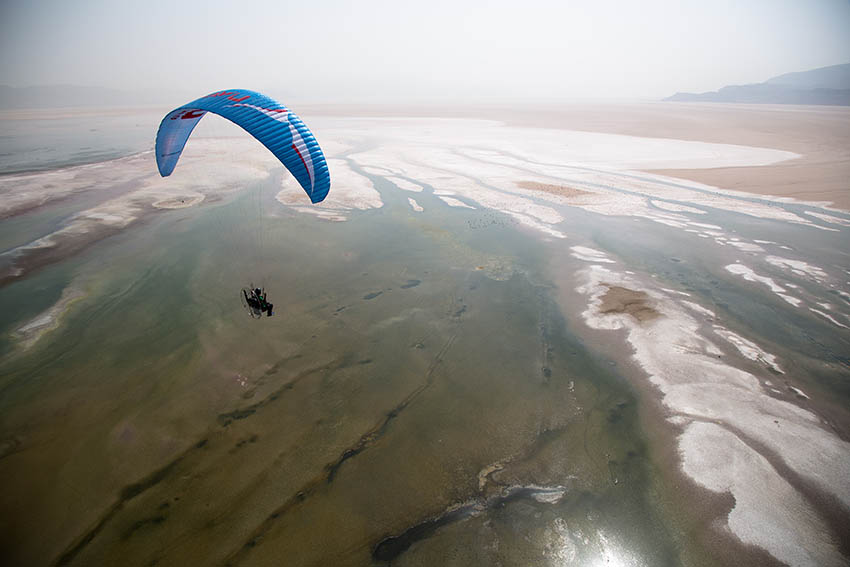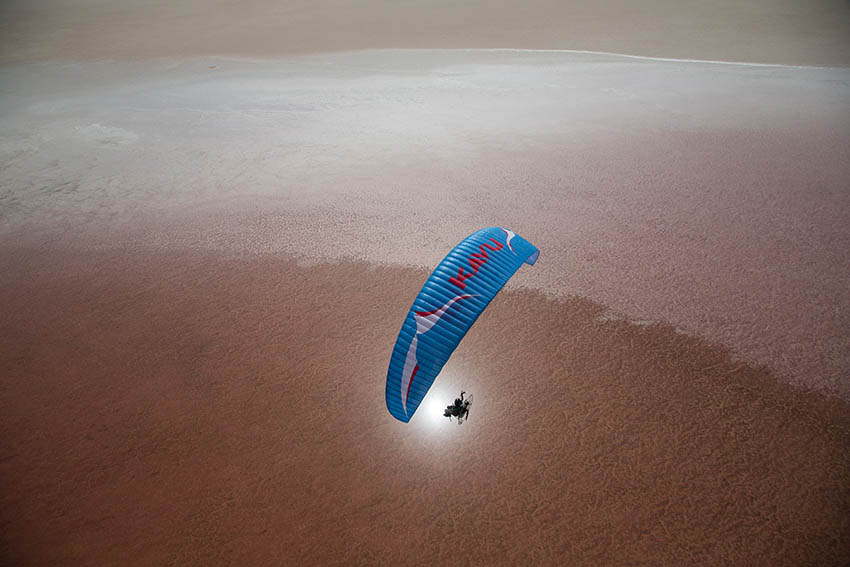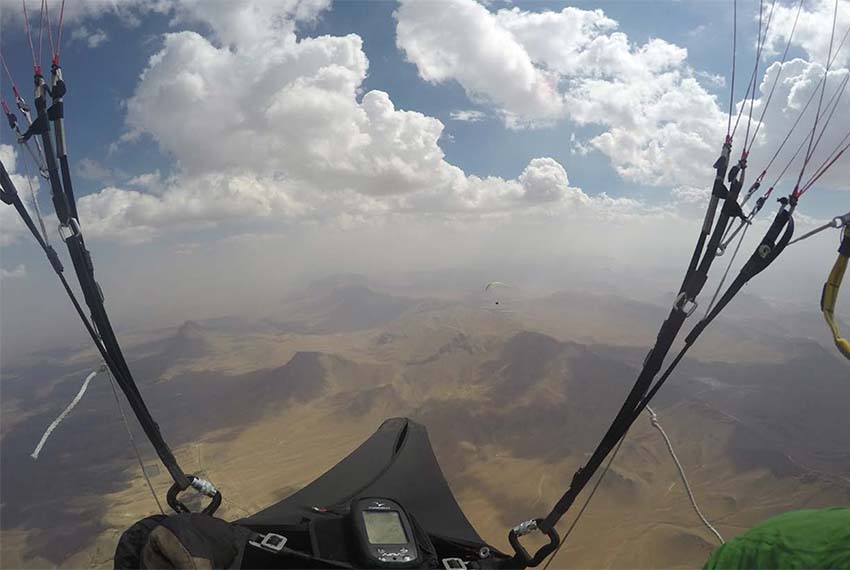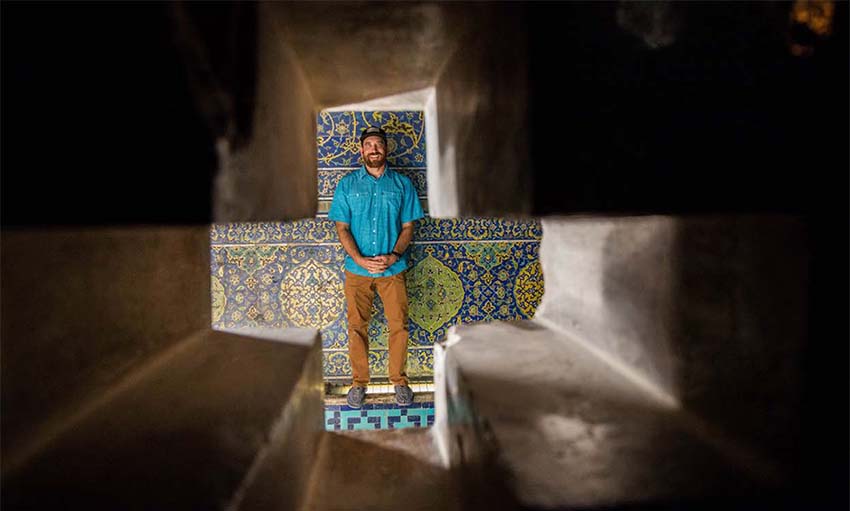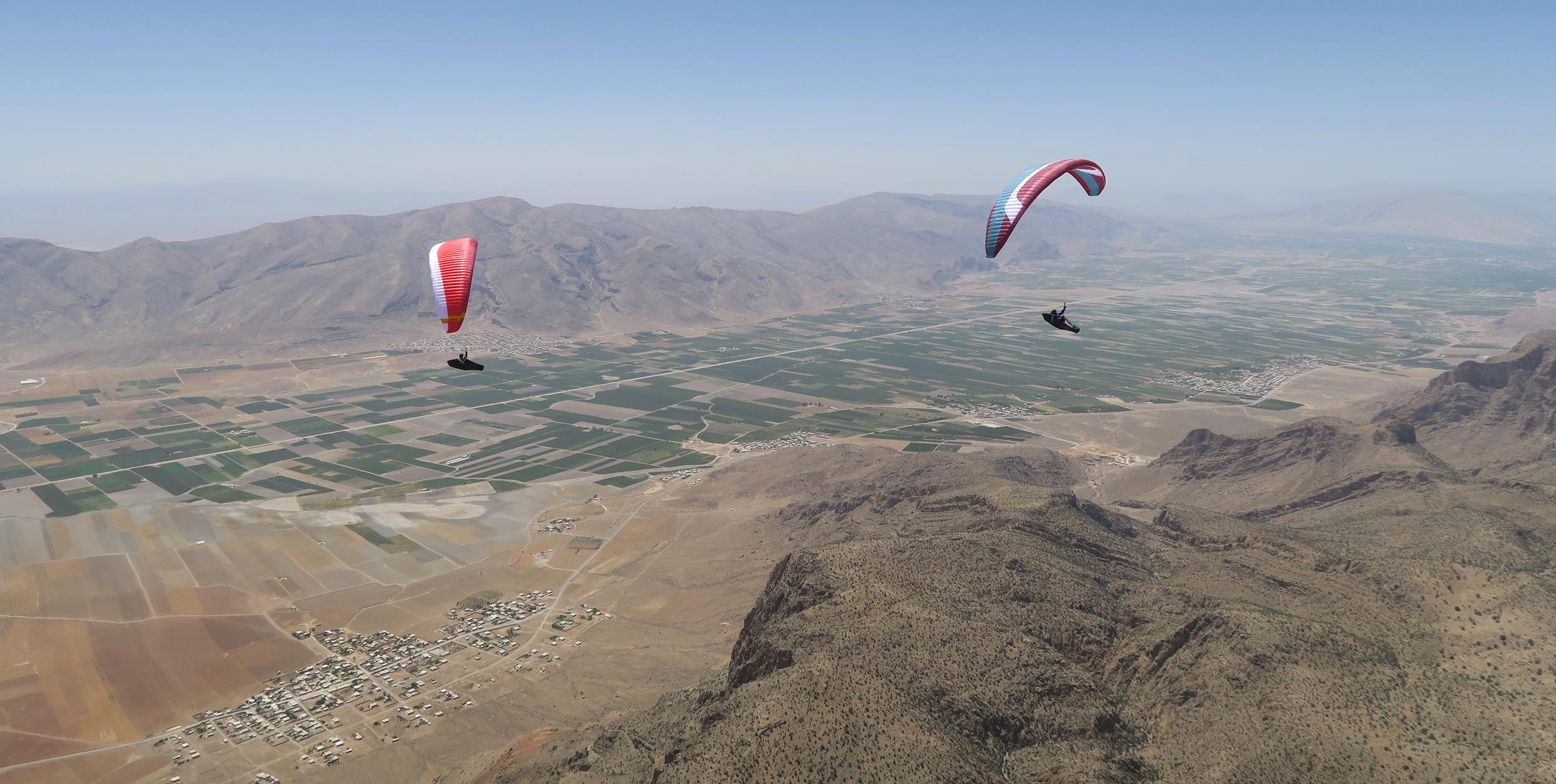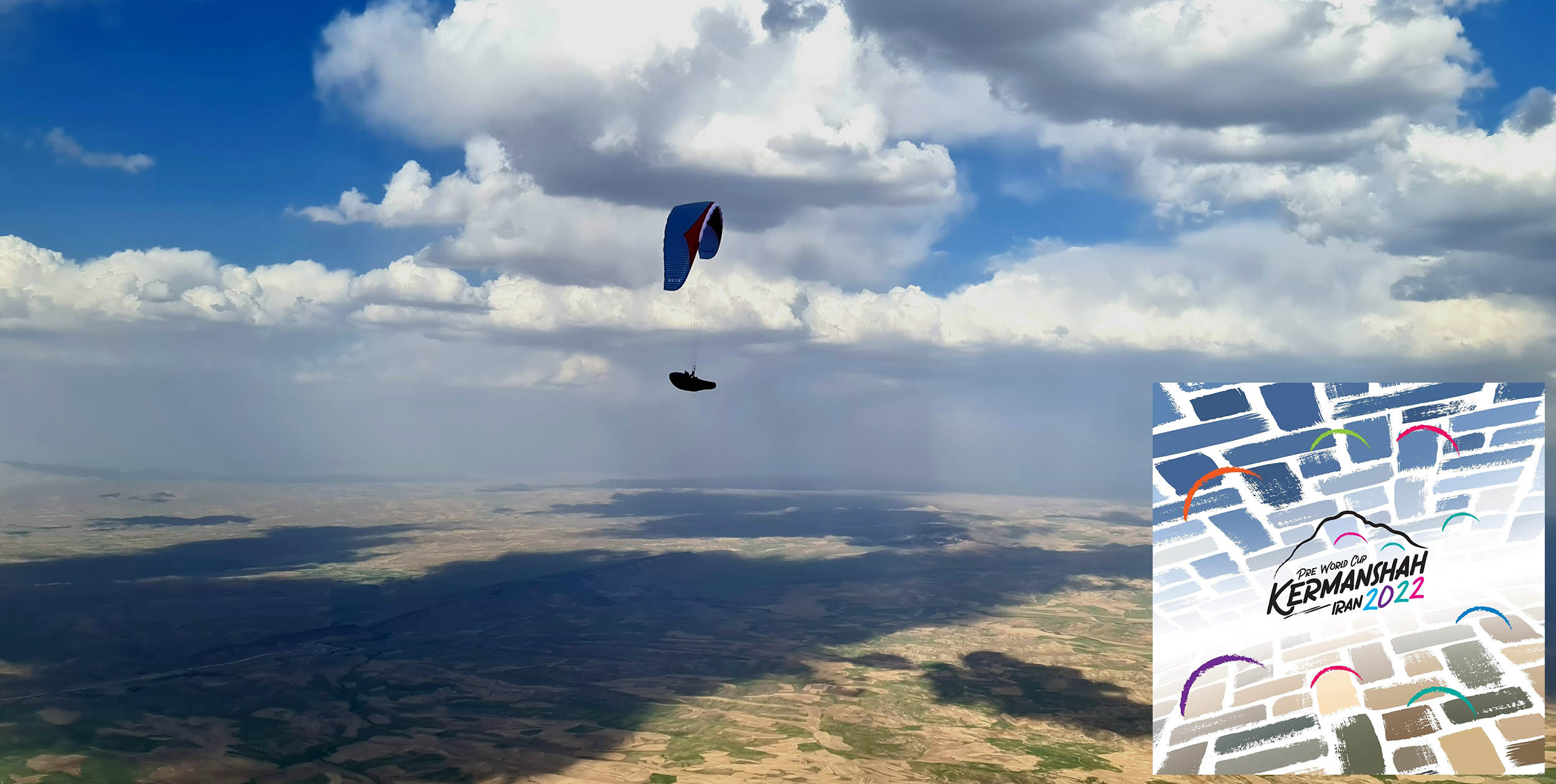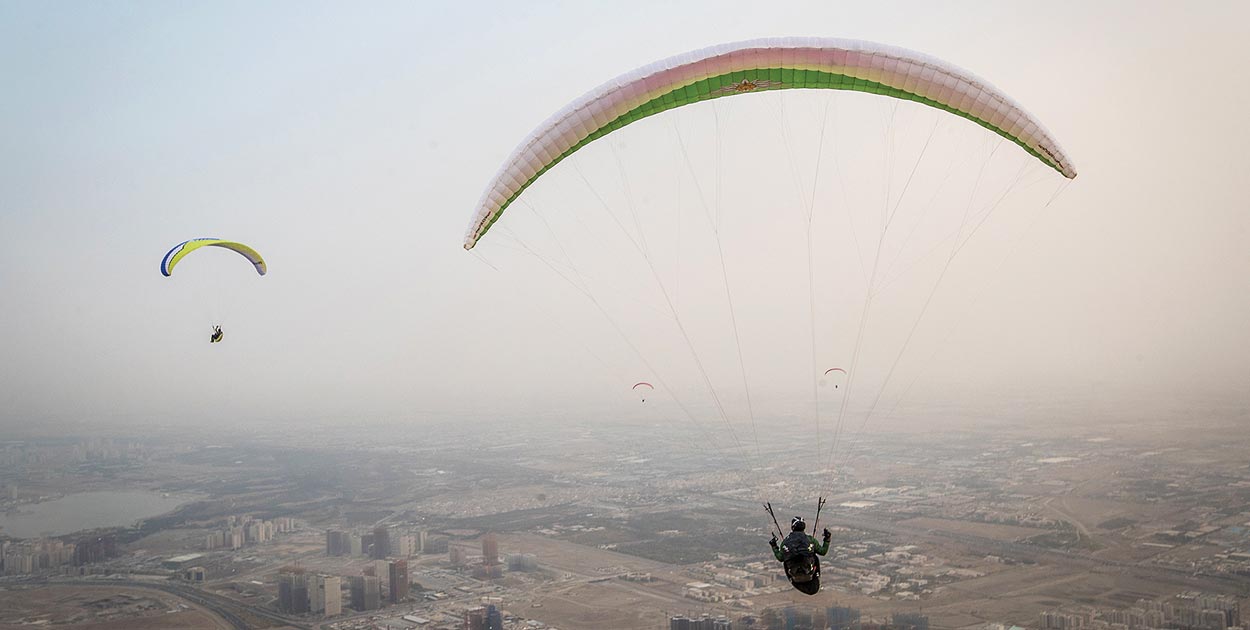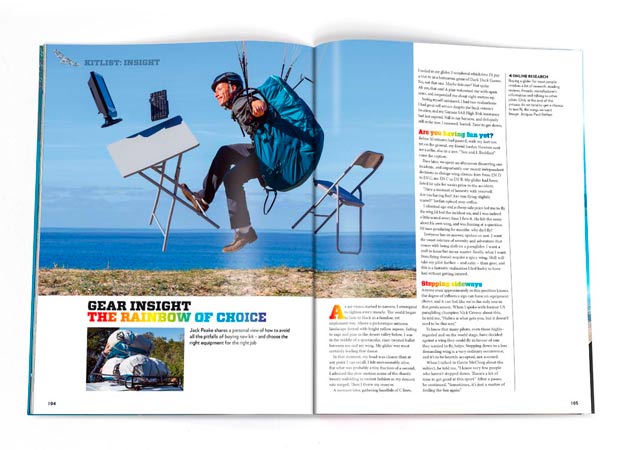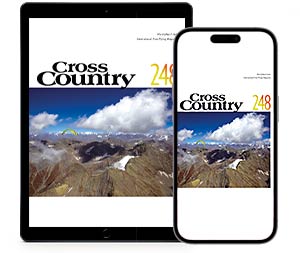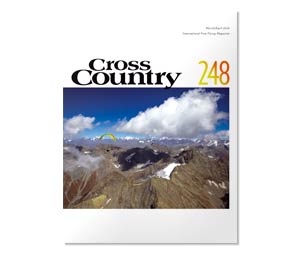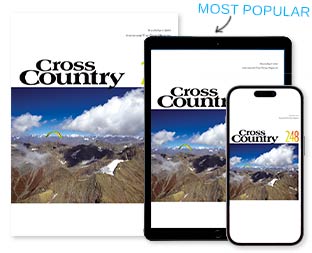Nick Greece was obsessed with the idea of flying in Iran, but as a US citizen it was almost impossible to visit. Then, a thaw in relations between the two countries allowed him a rare sporting visa, and a chance to fly in a country he knew little about…
For two years, the names Mohammad Razeghi and Soheil Barikani have appeared on my computer screen. We’ve exchanged posts on Facebook and developed a young-yet-burgeoning online relationship, leaving each other comments of mutual admiration. I’ve tagged them at scenic paragliding locales here in the United States. In return, they’ve tagged me at even better sites in their home of Iran. As my new Iranian friends’ photos continued to appear on my Facebook feed, I soon became deeply interested in visiting a country I knew very little about.
During my lifetime, Iran has been alternately vilified and ignored by the Western media. It’s become the proverbial ‘Ivan Drago’ from Rocky 4, a manifestation of every stereotype that triggers America’s exacerbated fear of foreign superpowers.
A year before I would get to go to Iran, my mother sent me an article about several pilots who’d been forcefully admitted into an institution with arguably the highest concentration of foreigners in the country – the infamous Evin Prison in Tehran. Because these adventure tourists had unwittingly landed inside a nuclear facility’s sensitive zone, they were immediately placed into custody and held, along with their Iranian host-pilot, for nearly four months.
Once I’d made up my mine to go to Iran, everyone I talked to about my upcoming visit predicted a similar outcome for me. Perhaps a few even hoped for it, so they could do a celebratory, “I told you so.” (You know who you are.) Family, friends, and strangers alike all reacted by projecting their own stereotype-based fears onto me.
“You’ll end up in jail,” they said.
“The Ayatollahs will keep you,” they warned.
“You’re gonna film and fly paragliders? You’re crazy!” To which I’d jokingly respond, “It won’t be so bad. Maybe I’ll come out twenty pounds lighter and with a book deal.”
This usually diffused the paranoia in the conversation, which would shift to the other, less harrowing aspects of a trip to Persia.
I found myself motivated by both a yearning to see what lay behind Iran’s cultural veil and a desire to disprove the barrage of extremist stereotypes forced down our throats by the mainstream media. With Homeland, Madame Secretary, and the ever-vigilant, fair-and-balanced Fox News relentlessly perpetuating the stereotype Iranians as bomb-and-turban-wielding zealots, I came to see it as my duty as a sportsman to get a glimpse of the real Iran and report back what I experienced.
My timing was fortunate. As the USA and Iran began talking under the guidance of President Obama and Iran’s new president Hassan Rouhani, who’d been elected with the hope of reducing cultural and geographic isolation, I entered their country and set out as the first American paraglider pilot to go on a flying road trip throughout Iran. No handlers, no government sycophants – just pilots on the road.
Some points to clear up right away: Iran is thriving, even in the face of crippling United Nations and US sanctions. Selfie-sticks and rhinoplasty are popular and Facebook is accessible through VPNs, though Tinder, well, not so much.
No alcohol is readily available in public venues, but the Iranians have turned concocting non-alcoholic libations into an art form all its own. Religion is at once all-governing and quietly subdued. Domestic flights are packed with vacationers en route to holy sites or sites of antiquity in Mashad, Yazd, Shiraz, or Tabriz.
While imported vehicles are extremely pricey, for example, a Toyota Camry is exorbitantly expensive, much of the population drive Iranian manufactured Fiats. The food is outrageously good and plentiful. Ironically, or perhaps not, younger locals prefer fast food like fried chicken, pizza, or a lesser quality rice and meat option to their delicious national cuisine. Travellers should note that no towels are provided with lodging.
Last, and most important, Iran’s people, as a rule rather than an exception, are among the most welcoming, considerate, kind, and generous I’ve ever encountered in my years travelling all around the globe.
****
Unsurprisingly, getting in to Iran was no easy feat. After being told every month it was “imminent,” it actually took two years to get a visa reference number. In 2014, a team of US pilots were all set to go and assured everything was in order. But when our day of departure arrived, the visas did not, and so our trip was abruptly cancelled.
By the following year I was the last one committed to flying Iran, passing up numerous other projects and anchoring myself at home in case that elusive reference number came through. I was told it would be a matter of days, but months slowly passed without any sign of my number.
Officials informed me that timelines for sporting visas for US citizens are difficult to predict, and mine was no exception. By September 2015 I’d resigned myself to never seeing Iran. As often happens in life, just as I gave up, my reference number finally arrived.
I received my permit late on a Sunday night. On Monday, I packed and wrapped up as much work as I could. Tuesday I flew to Washington, D.C., so I could apply for my visa in person on Wednesday and depart that same evening.
The embassy was filled with soon-to-be travellers. A gentleman next to me, curious about what appeared to be the only non-Iranian in the room, quietly inquired, “You go to Iran?”
“Yes, sir,” I responded.
“Aren’t you afraid of the danger?”
To be honest, up until that point, I hadn’t been. I struggled for a reply.
“It’s perception versus reality, isn’t it?”I asked hopefully.
I’d started strong, but the second those words came out of my mouth I began to falter, wondering just who I thought I was to be spouting such potentially naïve ideology.
He nodded his head, but my strong footing had been shaken. Waiting my turn, I contemplated my decision to go and the accuracy of my worldview. Yet when I got to the window I submitted my documents and secured my returned passport and visa. By 10.30pm I was on a plane headed to Iran.
Like what you’re reading? You will find plenty more like this inside Cross Country magazine. Here’s what some of our readers say:
“Honza Rejmanek’s new met article helped me enjoy a magical flight yesterday. Thank you for a wonderful publication” – Dan Corley, USA
“I love your magazine more than anything.” – Urs Haari, Switzerland
“Cross Country has a massive impact on pilots’ awareness, worldwide. Great job in inspiring and sharing knowledge!'” – Ben Kellett, New Zealand
I arrived in Tehran late the next night after three airports and 17 hours. A frequent traveller, I knew how to comply with airport personnel so as not to risk the ire of over-zealous civil protectors. The Iranian admission process was easy, even friendly. With the exception of fingerprinting, that is, a task both the officials and I were eager to get over with during the wee hours of the morning. One of them, a young officer, extended a good-natured welcome. “You must try Dili Kebab when you are here,” he insisted as he processed my papers and sent me on my way.
Soheil Barikani, Iran’s number one pilot, was on hand to pick me up and ushered me to the luxurious Hotel Evan. Ironically, this is also the name of the famous gulag where political prisoners and foreign nationals are held.
Soheil had given up a solid job as a mechanical engineer in order fully dedicate his life to paragliding and, after six years in the air, had won several World Cup tasks. He confessed he’d become obsessed with racing paragliders, often paying for his frequent travel by selling the prizes he won, importing flying gear, and teaching SIV courses. To obtain a visa, Iranian pilots often have to travel to Turkey or Dubai just to visit the embassies of the countries they wish to visit, as there are very few diplomatic operations in Iran.
Over the next two days, Soheil and I spent a lot of time together in the car, crawling through Tehran’s slow, steady traffic sharing a prodigious amount of knowledge about our esoteric adventure sport – from reserve tosses to comparing sport-defining wings ranging from the Avax RSE to the Mantra 10.2. Luckily, we could nerd-out for hours, lost in our mutual obsession for free-flight minutiae.
On the first day of our journey we visited the Azadi Tower on Freedom Square, which stands on the western gate of a massive, nine million strong Tehran. Built in 1971 to commemorate the 2,500th anniversary of the Persian Empire, this ‘Gateway into Tehran’ was named the Shahyad (King’s Memorial) in honour of the Shah, but was later changed to Azadi (Freedom) after the Revolution of 1979. Hossein Amanat, a Baha’I, was the architect who planned the elegant, 45-metre-high tower, but he was driven from the country by the revolution and subsequent removal of religious pluralism.
When I exited the car to take photos for the first time in Freedom Square, truth be told, I was deeply intimidated. The vilifying rhetoric ground into me back home had taken root, even though I prided myself on being an open-minded individual.
That evening we met Lilly, a pilot who lives in Tehran with a second home in Tabriz, where she imports auto parts from Turkey. Slim and blonde, she was dressed as if she’d just finished a yoga class. Lilly, who’s been flying for a few years, greeted us with a smile and beverages. Lilly has been fighting both publicly and privately to live the lifestyle she desires under a relatively all-encompassing system of government control. A young woman living on her own in Tehran, business owner, crusader against the chador (the clothing worn by Muslim women that covers everything but their face), and paraglider pilot are just a few of this remarkably strong woman’s defining characteristics. She quickly made a positive impression.
Adventure sports attract individuals who seek out and cherish life experiences. They’re an interesting mix of thinkers, doers, gypsies, risk-takers, fear-conquerors, curiosity-seekers, explorers, thrill-seekers, addictive personalities, ADD riddled-minds who’ve found their condition beneficial, problem solvers, the ruggedly defiant, or those demanding control over their own lives in the face of intractable fear.
The Journal of Personality and Sociology postulates that the motive for skydiving is strongly associated with sensation seeking; the motive for mountaineering is strongly associated with emotions related to a desire for self-regulation. We soon discover that the three of us sit directly in the middle of these two subsets. And while hailing from a New York suburb versus Tehran couldn’t be further from a shared reality in the nurture column, we shared a lot in the nature side of the equation.
The next day, I met with Mohammad Razhegi, the contact who had secured my visa. He informed me that he was headed to Turkey for an APPI training course and that Soheil would take good care of me. After a long conversation and a delicious meal, Mohammed escorted me to a hasty roadside hand-off to Soheil, where a photographer for the Iranian Paragliding Association’s magazine snapped a photo of all of us. It was late, we were on a dark road with cars whizzing by, and, much to my surprise, my caretakers started screaming at each other in Farsi, as the photographer and I shared an awkward desire to be anywhere but there.
I learned later that the anger was sparked in Soheil from our late arrival at the arranged meeting with him. He’d been waiting for hours and felt resentful about having to begin our five-hour drive to Esfahan. Soheil is a pilot’s pilot and could not believe that we had jeorpadised getting to launch the next day for a meal, and since he had planned for us to fly the Rokh, the crown jewel of big air flying in Iran, early the next morning, we had to get on the road. Even more infuriating was the fact that Mohammad did not have my flying permit from the National Association to send with me, which I would be required to present to the police if I landed anywhere but in official landing areas. Not having the permit presented a problem for Soheil as his liberty was directly tied to mine as my new guide.
My instinct for preservation manifested slowly, but started to gain steam as I became increasingly aware of my tenuous understanding of what was happening around me. I was alone, flying as the first American paraglider pilot in Iran, and was toting at least six cameras. My hosts, my only safety net, were not seeing eye-to-eye, and I had no idea what they were arguing about. On numerous occasions over the next 10 days, Soheil spoke angrily into his phone, while trying to update Mohammad, who periodically checked in as to our whereabouts. I practiced a meditative mantra to put their conflict out of mind and convinced myself that all would be okay.
We drove all night, arriving in Esfahan at 1am. Every town we passed through was adorned with the faces of soldiers, celebrated for their ultimate service, who perished in the horribly grotesque, no-holds barred Iran-Iraq war (1980-1988) that claimed more than 500,000 lives with many more than that injured. This seemed to be more than an honouring of fallen soldiers, but a constant reminder that all Iranian citizens may be called upon again to repel invaders at any cost necessary.
Soheil debated whether to stay with a local pilot or check into a hotel so my passport would be registered at a lodging, giving the officials the ability to track me. We took a chance and stayed with Mohammed Miralei, who epitomised Persian hospitality. Mohammed provided not only an amazing array of teas but also a lovely guest room, consisting of a large common sitting parlour with a kitchen, and showed me around the amazing city of Esfahan. Blankets were brought forth and unfurled over incredibly ornate Esfahan Persian rugs to make our beds. We set our alarms for an early start, and I fell asleep to the rhythmic pattern of Soheil’s snoring. One of his signature abilities is falling asleep in mere seconds of becoming horizontal, mouth agape, emitting a strong guttural orchestra until sunrise.
On the way to launch the next morning, we met Fateme Eftkari, Mohammad Semani, who holds numerous distance records at the Rokh, and four other eager pilots. The Rokh is one of the most famous places to fly in Iran and, in fact, the reason Iran popped onto my big-flight radar, after Oriol Fernandez and Mohamad Semnani put up numerous 200km flights on Xcontest.org.
The Rokh is an epic big-air site. It is 70 km from the historic city of Isfahan on the eastern side of Central Zagros mountain chain. As the biggest air site in Iran a decent number of pilots fly 200km flights every year and base can be at 6,500m. However, it sits near a military installation.
Rokh is also the site where a group of Slovakians and their Iranian host had inadvertently become entangled with the government in 2014, landing them in jail for more than three months. One of the pilots had set down inside the military installation, another turned out to be a nuclear scientist, and other members of the group were flying with large DSLR cameras as well as contraband. The incident became a debacle, and a huge weight for Soheil when we flew there as the previous group’s host had also served the same amount of time.
As an American without a flying permit in hand, and only the second foreigner to fly the site since the Slovakian incarceration, Soheil was stressed as he had previously been detained for flying over a military installation and he understood fully that his freedom was directly tied to mine. I was told not to bring the DSLR on this flight, to which I happily agreed, and to land in the designated landing zone. If I didn’t, there was a strong chance I (and probably he) would be detained.
The weather looked ideal, and I thought it would be reasonable to go anywhere I liked, and more importantly, return, for a few hours, assuming there was no catastrophic failure. Competitions and all the flying I’d done over the last 15 years gave me confidence I could reach any landing zone, if necessary. And in Iran, I knew I had to.
We took off and, after a little struggle, climbed, but when the inversion popped, I climbed to 15,000 feet (4,570m) adopting a conservative flying style. I wanted to be sure I returned to the exact spot where I had been told to land after our short 25-mile (40km) cross-country or, at the minimum, to land alongside my local guides.
After working for two years to get to Iran, flying the Rokh and climbing to the clouds with a gaggle of desert eagles and very skilled and enthusiastic Iranian pilots was all time. Soheil Barikani, Mohommed Miralei, Mohammad Semnani, and Iran’s best female pilot, Fateme Eftekhari, among others, made for exceptional company. And as I hypoxically glided along, I marvelled at how fast the team charged downrange. These pilots rocked. I found myself giddily exclaiming out loud, “These pilots are really good!”
Some say nothing good happens easily; in this case, they were correct. I carefully flew after my friends, made sure to top-out every climb and celebrated every glide in ecstasy. I had a GoPro on board, stabilised by a gimbal attached to my carabiner. GoPro had expressed interest in doing a piece on the trip, and I thought it would be an honour to present Iran and their amazing flying community to the world. As I went on glide, I did check-ins with the camera, full of jubilation, turned it around to perform follow-cam with my new friends, or just filmed the cloud streets we moved under along the way.
After an hour of flying, we turned around, due to a tricky looking transition and changing atmospheric conditions. While thermalling on the way back, I heard an odd metallic noise and watched in horror as my GoPro contraption spiralled down away from me, plummeting 15,000 feet toward very remote mountainous terrain. I stared, petrified, after it. A million thoughts flooded my oxygen and sleep-deprived mind. What if it hits someone? Or kills livestock? What if the authorities find it, and I am arrested for espionage?
The stupidity of the possibility of being put in jail for using a GoPro, while making a GoPro video, was not lost on me. It took a while to shake the feeling. Luckily, I was deep over uninhabited terrain at 5,000m when it fell. I never heard about the camera again, but occasionally wondered if an authority would show up with hard questions over the next few days.
The sky began to turn nasty as the clouds guiding our return started to grow with such speed that they blocked various corridors around us. We flew back toward launch and landed directly below, about an hour before the entire sky overdeveloped and a gust front ripped through the landing zone. The excitement was palpable. We shared high fives and tales of eagles screaming past us in strong climbs. The only difference from a normal day at my local big-air site was the absence of a cooler in a truck in the LZ.
Packed up, we headed into Esfahan to eat lunch and admire the sites. While walking through a maze of covered-market-stalls touting their wares, we spotted both locals and a steady trickle of tourists who are cautiously returning to Iran after President Hassan Rouhani put in a significant effort to reconnect the country with the outside world. This is a path that all of the middle-to-upper class pilots I met were extremely excited about, but perhaps was not as appreciated by the people who rallied around his opponent, Ahmedinajad.
We continued to wander through the souk, eventually popping out onto a breathtaking plaza, which the group of pilots proudly identified as a UNESCO World Heritage site and one of the largest plazas in the world – Imam Square. A gathering of other intrepid travellers wandered about, taking photos, seeming to enjoy the freedom and social interaction with locals. Local clowns put on shows for Iranians and their children who laughed and ran throughout the square as their parents conversed. Persians use any opportunity to collect and enjoy the company of others, even though they also, like Americans, are obsessed with their cell phones.
As we were travelling, Soheil was supposed to report to Mohammad, who was supposed to report to the Ministry of Sport, who was supposed to report to the ‘government’ the details of where I was, what I was doing, and where I was staying, every few hours. This became a very laidback procedure, without any significant oversight. Most evenings Mohammed texted Soheil for updates, and Soheil commented, “If he were with us, he would know where you are.” It was entertaining but a bit unsettling at the same time, like having parents embroiled in a battle.
Like what you’re reading? You will find plenty more like this inside Cross Country magazine. Here’s what some of our readers say:
“Honza Rejmanek’s new met article helped me enjoy a magical flight yesterday. Thank you for a wonderful publication” – Dan Corley, USA
“I love your magazine more than anything.” – Urs Haari, Switzerland
“Cross Country has a massive impact on pilots’ awareness, worldwide. Great job in inspiring and sharing knowledge!'” – Ben Kellett, New Zealand
Life in Iran, like the driving, can be simultaneously chaotic yet peaceful and full of moments of considerate coexistence where everyone works together so each can move forward more quickly. Considering the number of close encounters that occur each minute of every drive, with such sparing use of the horn, one can see it is a game of give and take. Vehicles form a fascinating space of both private, and public life, and the driving in Iran reflects the constant balance that Iranians must carefully manage between those two spaces.
We rallied back to Tehran to catch a domestic flight from Mehrabad Airport to fly to Shiraz on a completely full flight. After checking in I sat across from a mullah with a black headwrap, signifying that he is a direct descendant of Mohammed. He on his iPad, and I on my iPhone downloading the most current This American Life episode. A team of bulging weightlifters wandered around waiting for a flight. Soheil recruited his best friend, Sadr Barikani (no relation to Soheil), to accompany us. I could tell he was elated to talk with a countryman in his native tongue, after spending 15 hours over two days driving with an English-only speaker.
We arrived in Shiraz, a proud, historic, bustling city filled with both high-end hotels and sites of antiquity. Shiraz hosts throngs of tourists poised to explore epic Persian sites of antiquity – the Tomb of Darius the Great and Persepolis.
Because I mentioned I lived in Salt Lake City, Utah, my guides took me out early to the Maharlo Salt Flats. We arrived to a full-on American West experience, replete with burning two-stroke oil wafting through the air as dirt bikes, paramotors, trikes, and tents popped up all around us. I’m not sure how you say “redneck” in Persian, but after many years living in the Rocky Mountain West, I felt right at home.
A father and son tandem trike outfit, the Asadi family, pulled up in a new Toyota Hi-Lux loaded with a beautiful trike and new paramotor, wearing the huge smiles of a team that is about to have a ball at work. We helped them unload and, as we were just about finished, a father of one of the pilots invited us for the a warm, delicious breakfast of porridge and homemade bread. Through gestures he made me feel completely at home and welcome.
Because an official from the local airport was on the scene, everyone decided it would be better if Soheil flew and I took photos from the trike tandem, piloted by the young Asadi. This was the only location where I got an uptight feeling. It was great for me to be on the front of a trike with cameras in hand piloted by a phenomenal pilot. We took a magnificent tour of epic algae formations and colours, stirring thousands of flamingos that called it home and returned back to the camp, so the duo could continue working, flying tandems for cash.
We spent the rest of the the day touring Persepolis and the Tomb of Darius. Persepolis is situated 60km northeast of Shiraz in Fars Province, Iran. The earliest remains of Persepolis date back to 515 BC. This Unesco World Heritage site was named the capital of Persia around 522 BC. The epic palace was eventually conquered by Alexander the Great on his ride through Mesopotomia, around 330 BC. Seeing such an ornate and rich historic site was inspiring, and as we watched the sunset over the compound from up above the city, I felt giddy, knowing that I was roaming around ancient lands that were thriving a good 2,000 years before Europeans had even found North America.
The next day we returned to Tehran, where we planned to fly Damavand with the legendary Paragliding World Cup pilot Alireza Esna Ashari. Alireza spent years on the World Cup tour and was, in many ways, the most internationally known Iranian pilot before Soheil hit the scene.
He bailed out of a successful family business to build an A-frame at the base of one of the most consistent and epic flying sites in Iran, just one hour from Tehran. His relocation was just like 95 percent of my friends in the US who headed West to make their own way in the mountains, and his carefree attitude immediately set me at ease.
We settled into Alireza’a care as he ushered us around the small town and set us up for two of the best flights I had—one a 30 mile cross-country in front of a 6,000m volcano, and the other, a lovely glass-off session with 25 other pilots. In between, we were treated to one of the finest meals I have ever eaten, full of berry, nut, saffron and lamb flavours.
Due to a hectic schedule, this article has taken a year-and-a-half to publish. During that time, a popular movement swept a questionable candidate up to the highest position in the USA, and the borders with Iran have been essentially closed proactively and reactively by those in power.
People have asked what my views on the political state are, or what I think about various other crises in various parts of the world I have been extremely fortunate to visit. And as I think about those issues, I have opinions that are somewhat educated, but the truth of the matter is that I am an expert in paragliding and that is all I can comment on with authority.
In regard to our sport, I say that the Iranian flying community and pilots are some of the most welcoming, skilled, passionate, and driven in the world. Being part of this worldwide community is the greatest weapon we have for breaking down illogical stereotypes. During these troubling times, it makes me a little more comfortable knowing that political demagogues will come and go, but like-minded people on both sides of the fence will remain the same.
Nick Greece is a US competition and adventure pilot, writer and photographer
First published in Cross Country 178, April 2017

